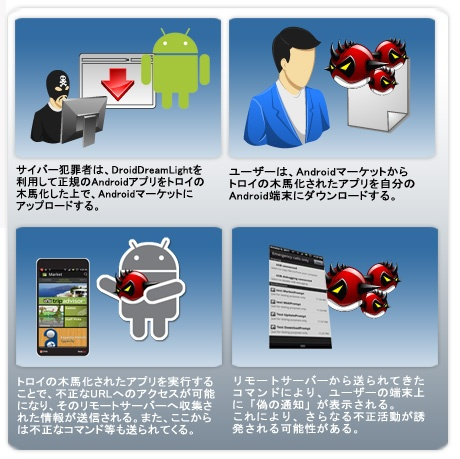
DroidDreamLight malware represents a new wave of Android threats, impacting tens of thousands of devices worldwide. As the second iteration of the infamous DroidDream threat, this malware cleverly disguises itself as fake Android apps in the marketplace, posing a significant risk for unsuspecting users. Its functionality mirrors that of its predecessor, with an alarming ability to contact remote servers and transmit device information, even when the infected application isn’t active. Thankfully, the risk of infection is somewhat reduced as DroidDreamLight cannot download additional malicious packages in the background. However, it remains crucial for users to take proactive measures to protect their Android devices, including utilizing effective anti-malware for Android that can mitigate the ill effects associated with DroidDreamLight.
The emergence of DroidDreamLight highlights the ongoing battle against malicious software targeting mobile platforms. This newly identified Android malware is an evolved version of previous threats, showcasing how cybercriminals adapt their tactics to exploit vulnerabilities. By employing deceptive strategies, these programs can still spread through seemingly legitimate applications, underscoring the importance of vigilance among users. For individuals seeking to safeguard their devices against such threats, the integration of reliable anti-malware solutions is essential. As Android devices continue to dominate the smartphone market, ensuring protection against dangers like the DroidDreamLight effects becomes ever more critical.
Understanding DroidDreamLight Malware
DroidDreamLight malware represents a significant evolution in Android threats, following the footsteps of its predecessor, DroidDream. This new strain has already impacted tens of thousands of devices, injecting a new level of urgency in the fight against Android malware. Much like DroidDream, DroidDreamLight uses counterfeit applications available in the Android Market to proliferate. However, the key difference lies in its functionality; while it can initiate data exchange with remote servers without user intervention, it does not possess the capability to stealthily download malicious packages in the background—making its infection vector more visible to users.
As DroidDreamLight interacts with an infected device, it is capable of transmitting critical device information to external servers. This includes the device’s IMEI, IMSI, and specifications, opening doors for potential exploitation. Users need to be vigilant as even legitimate apps can harbor malicious code repackaged by cybercriminals. The rapid evolution of Android malware exemplifies the need for continuous education and precaution as malicious actors continuously adapt to breach security measures.
The Threat Landscape of Android Malware
The Android ecosystem, while beneficial for users worldwide, carries inherent vulnerabilities, primarily due to its open-platform nature. As users enjoy the flexibility of installing applications from various sources, they also expose themselves to an increasing number of threats like DroidDreamLight. The ease of access to app development results in many untested applications flooding the market, presenting an inviting opportunity for malicious versions to infiltrate unsuspecting devices.
In this constantly evolving threat landscape, awareness is key. That includes understanding how Android malware functions, such as the mechanisms of DroidDream and its variants. Knowing that applications can be weaponized, users must adopt proactive measures for protection—specifically through reliable anti-malware programs tailored for Android devices that can detect and neutralize threats before they execute harmful commands.
Identifying Infected Applications
Identification of infected applications is essential to safeguarding your Android device from malware like DroidDreamLight. Users should be especially wary of newly installed apps that exhibit unexpected behavior or performance issues. While popular apps often dominate downloads, counterfeit versions can easily masquerade as trusted software, making it crucial to inspect permissions requested by applications before installation.
Many of the compromised applications associated with DroidDreamLight appeared legitimate, but upon closer inspection, their ulterior motives reveal a malicious agenda. Users should remain cautious and consider downloading apps only from reputable developers and verified sources. Eliminate any suspicious applications promptly and utilize built-in security features and anti-malware tools to scan your devices regularly.
Best Practices to Protect Android Devices
Protecting your Android device from threats such as DroidDreamLight hinges on adopting best practices for mobile security. One of the foremost measures is the installation of a reputable anti-malware solution designed specifically for Android. Applications like Lookout and AVG for Android provide a robust line of defense against a variety of malware strains, including camera permissions and harmful behavior.
In addition to utilizing anti-malware, users should maintain software updates not only for the operating system but for all installed applications. Regular updates often contain vital security patches that can mitigate vulnerabilities and reduce exposure to threats. By adopting these preventive strategies, users can significantly diminish the risk of falling prey to malicious software while enjoying the benefits of their Android devices.
The Role of User Awareness in Malware Prevention
User awareness plays a crucial role in the prevention of malware infections. Understanding the potential risks associated with downloading and using apps on an Android device can dramatically reduce the chances of falling victim to threats like DroidDreamLight. Users must adopt a vigilant approach by assessing app reviews, permissions, and developer reputation before installation to avoid potential malware.
Furthermore, educating oneself about the signs of malware infection—such as unusual device behavior, excessive battery drain, or unsolicited advertisements—can aid in early detection. Equipped with knowledge and practical advice, users can transform their Android usage habits and navigate the digital landscape more safely.
Updating Security Measures Against DroidDreamLight Threat
To effectively combat threats like DroidDreamLight, it is vital to keep security measures updated. As threats evolve, so too must the tools we use to defend against them. Regular updates to your anti-malware software not only provide the latest threat databases but also enhance the software’s capabilities against emerging vulnerabilities.
Additionally, users should explore new features offered by security applications, such as real-time scanning and advanced privacy tools. By staying abreast of the latest developments in mobile security, individuals can ensure their Android devices remain protected against the dynamic landscape of Android malware.
Utilizing Android’s Security Features Effectively
Android devices come equipped with a plethora of built-in security features designed to protect users from malware threats like DroidDreamLight. Features such as Google Play Protect actively scan apps for harmful behavior, while permissions settings allow users to control what data and functions apps can access. Leveraging these tools can create a formidable barrier against potential malware threats.
Additionally, users should familiarize themselves with secure browsing practices, such as avoiding suspicious links and unnecessary downloads from untrusted sources. By combining Android’s inherent security features with personal vigilance, users can cultivate a secure environment that significantly reduces the risk of encountering malware on their devices.
Responding to Malware Infections Promptly
In the unfortunate event of a malware infection, prompt action can mitigate damage significantly. If you suspect that your Android device is compromised by DroidDreamLight, immediately disconnect from the internet and remove any suspicious applications. Following this, utilize your anti-malware software to perform a thorough scan and eliminate any detected threats, ensuring that no remnant of the malware persists.
After addressing the immediate threat, it is advisable to change all sensitive passwords and monitor financial accounts for any unusual activity. Taking these precautions not only protects your current device but fosters a culture of proactive security management for future mobile use.
The Evolution of Android Malware and Future Trends
The landscape of Android malware is continuously evolving, with increasingly sophisticated attacks such as DroidDreamLight leading the way. As the popularity of Android devices increases, so does the incentive for cybercriminals to exploit vulnerabilities. Future trends likely indicate a rise in smart malware capable of bypassing traditional security measures and leveraging new technologies such as machine learning and artificial intelligence.
To effectively combat these imminent threats, both users and developers must remain vigilant and adaptive. Constant updates to security protocols, the use of advanced detection methods with a focus on real-time analysis, and user education can collectively fortify defenses against an unpredictable future of Android malware.
Frequently Asked Questions
What is DroidDreamLight malware and how does it affect Android devices?
DroidDreamLight malware is a type of Android malware that affects devices by masquerading as fake apps on the Android Market. It can download malicious packages once installed, although it cannot perform these actions in the background like its predecessor, DroidDream. It can still compromise user privacy by sending device information to remote servers when specific actions, like incoming calls, occur.
How does DroidDreamLight spread among Android users?
DroidDreamLight spreads by disguising itself as legitimate apps on the Android Market. Users download infected applications, often with enticing names, leading to a risk of malware exposure. Once installed, it sends device specifications to remote servers, making it crucial for users to be cautious when downloading apps.
What can I do to protect my Android device from DroidDreamLight and other malware?
To protect your Android device from DroidDreamLight, download a reliable anti-malware application such as Lookout, AVG for Android, or SmartGuard Mobile Security. Keep the software updated and avoid downloading apps from unknown or suspicious developers to enhance your device’s security.
Are there specific apps to watch out for regarding the DroidDreamLight threat?
Yes, recent reports have identified several apps associated with the DroidDreamLight threat, including Magic Photo Studio, Sexy Girls: Hot Japanese Sexy Legs, and many others. If you have downloaded these or similar apps, it’s important to run a malware scan and remove any suspicious applications.
What are the main risks associated with DroidDreamLight effects on Android devices?
The main risks of DroidDreamLight include unauthorized data transmission, privacy invasion, and the potential for further malicious activities, such as downloading additional malware when triggered by phone state events. Users can face significant privacy risks if infected.
How can I identify if my Android device is infected with DroidDreamLight?
Signs of DroidDreamLight infection may include unusual data usage, unexpected behavior from apps, or receiving strange incoming calls. Running a malware scan using an anti-malware app can help confirm if your device is infected.
What should I do if I suspect my device has DroidDreamLight malware?
If you suspect your device has DroidDreamLight malware, immediately uninstall any suspicious apps, run a scan with an anti-malware program, and consider restoring your device to factory settings if the problem persists.
Can DroidDreamLight malware spread without user interaction?
While DroidDreamLight cannot download malware in the background, it can still interact with a device autonomously through specific intents, such as receiving incoming calls. This highlights the importance of vigilance when handling app permissions.
Is there a way to report DroidDreamLight malware?
Yes, if you encounter apps or activity that you suspect relate to DroidDreamLight malware, you can report them to Google Play or your device manufacturer. Additionally, sharing your experience on cybersecurity forums can help inform others.
Will DroidDreamLight malware return in the future?
While currently removed from the Android Market, there is always a risk of similar threats resurfacing. Users should consistently practice safe downloading habits and keep their anti-malware applications updated to guard against future iterations.
| Key Point | Details |
|---|---|
| Threat Overview | DroidDreamLight malware has affected between 30,000 and 120,000 Android devices. |
| Evolution | It is a second iteration of the original DroidDream, which emerged last March. |
| Spread Method | Uses fake apps in the Android Market to disseminate itself. |
| Behavior | Sends device information to remote servers once infected. It activates upon receiving specific intents, like incoming calls. |
| Vulnerability | The malware can contact remote servers even if the app isn’t running. |
| Infected Apps | Apps like Magic Photo Studio and Sexy Girls are known to be infected. |
| Protection Tips | Experts recommend using anti-malware programs like Lookout or AVG and keeping them updated. |
Summary
DroidDreamLight malware presents a significant threat to Android users, having already affected thousands of devices through malicious applications. To mitigate this risk, it is crucial to stay informed about the latest security issues and to employ reliable anti-malware solutions. Users should be especially cautious of suspicious applications and ensure their security measures are up-to-date to protect their devices from such malware threats.



